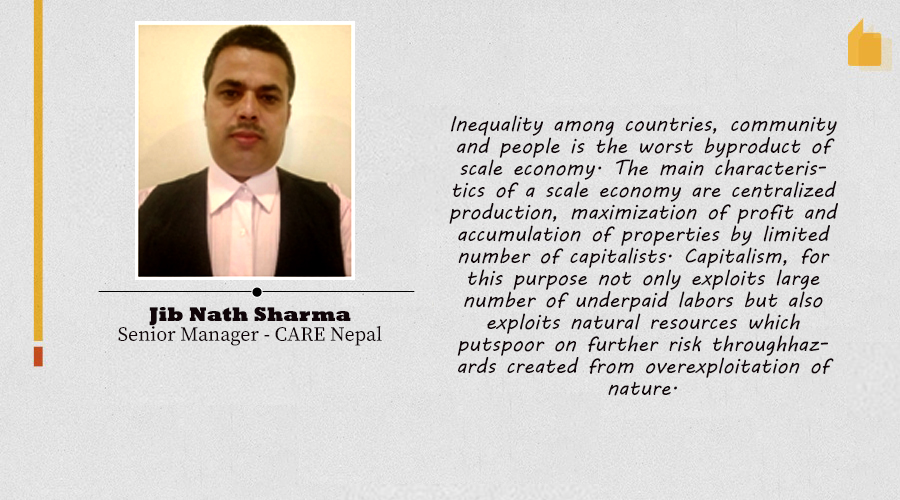Missing ‘the middle’: development paradox of underdeveloped
- Nature Khabar

-Jib Nath Sharma
In the recent development paradigm, the terms “scale economic “and “localization” are popularly used by different development organizations. The former connotes the large-scale development initiatives aligning with the capitalistic world market system’sincreasingly centralized production and decentralized distribution system visibly manifested in towns and cities. Invariably, these trajectories infer extensive displacement of peasants and rural artisans along with theirrelated knowledge primarily due to their historically disadvantaged capitals. Likewise, “localization” refers to the context-based development with the participation and leadership of thelocal community. Community members work together to identify goals as per their needs and interests, develop their own implementation plan and establishrequired collaborative relationships among the members and external actors.
Thisarticle mostly focuses on the nuances of scale economics and its paradoxes inunderdeveloped countries. The analysis is based around pertinent discourses related to setbacks in product marketing facedby peasants and artisans as a side effect of scale economics and economic liberalization.The scale economics here does not limit to internal scale in a single factory or value chain rather focuses on the trend of recent economic development in underdeveloped countries.
The concept of scale economics sounds pleasant as it increases efficiency in the production process and thereby increases overall productivity. It emphasizes mass production using improved inputs and technologieswhich reduces the production cost by using smart management and product distribution through extensive self-operating marketing network extended up to household level across the world. From a macrolevel growthperspective, one can assume there is no harm in promoting a scale economic approach.
The locus of scale economics concept isaround reducingproduction and distribution cost byadopting mass scale production and distribution through well-established cost-efficient network. In doing so, the fixed cost of entire production and distribution system spreads over large number of units of production. Additionally, variable cost also reduces asraw materials are procured in bulkandskill labor is mobilizedinefficient, specializedand axial manner.From the growth perspective, scale economy looks extremelyefficient benefitingeverynod of system however, when viewed through a humanistic and justice-oriented lens, it becomes essential to scrutinize who benefits from the system and who bears the brunt of its shortcomings.
Inequality among countries, community and people is the worst byproduct of scale economy. The main characteristics of a scale economy are centralized production, maximization of profit and accumulation of properties by limited number of capitalists. Capitalism, for this purpose not only exploits large number of underpaid labors but also exploits natural resources which putspoor on further risk throughhazards created from overexploitation of nature.
In the past and even today in underdeveloped countries,it’s unanimously agreed thatruralpeasantsand artisans have been the central axis of the national economy. A significant amount of GDP comes fromsmall-scaleproducers such as peasants, artisans and informal sector workers. This remains until producer communities are not connected by the road and the counties rigorously liberalizetheir economy.
Rural peasantries and protoindustrial artisans form a class externally subordination to stateauthorities as well as participateslowly with incredibly influencing market converting into market led producer and/or consumer. And they also tend to be associated with localizedvillage community life and traditional conformist practices. In such case, some communities remain self-sufficient from their own localized production systems and sell and exchange surplus to other deficit communities.Thus, the local initiatives are instrumental in fulfilling the local needs and provide a part of production to run the state.
Unfortunately, this situation prevails no longer. The level of production goes beyond the local demandthus the producergives up production or produces in a huge quantity for distant market. Small scale production cannot compete in urbanized areas. In this situation neither producers areorganized for specialized market led production, nor producer sufficiently upgrade themself as a large-scaleproducer. Additionally, there aren’t any mediating structures. Mediating middleshave not evolved because of their own limited capacity and skeptical behavior of the producers. This is the common reality of underdeveloped countries. As a result, external markets invade the local market with theexternally produced commodities. In turn, people go to the cities to work as labor. As a result,the previously developed production systemgets further worsened.
Localized production and distribution system despite its tremendous contribution to the state and society can no longer sustain as the globally operating centralized capitalistic market system has expanded up to thehousehold level. Currently, only competitive mass producers thrive as a market player in a system that otherwise would have disappeareddue to its own capacity. Thus,government are left with no options but to align scale production and distribution system.
Scale economics itself might not be problematic in ever transforming societies. However, its impact depends upon types of pathways:whether its scaling pathways build on the economic premises buildby small scale producer such as peasant and protoindustrial artisan having historically localized production and distribution system in different contexts or involves comprador capitalist displacing thelarge number of small-scale producers? How does the economy transit towards scale from small and subsistence mode of production and consumption?
On of theways to move society toward scale economy is to invite investors from outside and pull production system towards mass scale through external impulsionwhere existing small-scale producer either change into wage labors of the same investorsor seek employment in themarket.Many underdeveloped countries in the South Africa and North America in this path. Various corporatesectors hold the production resources and mobilize it for their own margin. Locals are either employed with capitalistic investor’s business or migrate outside seeking other livelihood opportunities.
The second modality is to leave everything up to the freemarket where high productive core cities and sectors pull the labor from rural small-scaleproducers. Gradually small-scale producers changeto laborers and urban consumers abandoning their own production. Currently, many underdeveloped countries from Asia have been passing through this trajectory. Production land in rural areas has turned into fallow land and along with these rural peasants and artisans have lost their ground. This trend is dueto low productivity in peasantries and rural artisan sectors as compared to other employment sectors available in market. Peasants and artisans rely on manual indigenous production system hence cannot compete with the mechanized production system.
Missing “the middle” in transitioning economy from one stage to another has been a common tragedy of both systems highlightedabove.
This tendency is tragedyfor subsistence and small-scaleproducers becausemarketing system from national to ground level serves as an externally produced commodity distribution channel displacing existing locally developed and maintained product marketing system. Externally invaded marketing system does not mediate to connect local products with external market linked to global system rather develops one-way market system to deliver corporate sector’s products up to rural communities. In absence of local market system connected with increasingly globalized market,local small-scale producers lose marketing platform and graduallytransformtowards wages labor and consumer.
Whilst the third mode of transitioning economic upgrades local production and distribution system completing different pathways stage. The pathways stage might be changing landless tenant producers to subsistence, subsistence to small scale, then gradually small scale to market led producer and small market led producer to commercial producer. Finally, from different stages many farmers give up on-farm based livelihoods and switch to off farm livelihoods. In course of transitioning from one state to another, production and distribution system develops various “middle” incrediblymiddling local products and market to the world economics.Peasantries and artisans take benefit of globally connected marketing system gradually upgrading themselves from small-scale producer to entrepreneurial mass scale producers. Aligning with this transformation path, service sectors and input suppliers also develop in the locality. As a result, locality developed market system linked local product with global market and channelized external commodities among the users. Accordingly, local markets are developed in different production pockets to propel products to global marketing platforms.
Missing the “middle”
In Nepal and globally, subsistence production system thrived for long time relying on family as basic production unit. The purpose of production was to meet the family need and small surplus for exchange or cash purpose to trade with basic needs of livelihoods not produced in own farm. The household production limited to continuing production cycle only to meet family and local needs but did not go beyond expanding accumulation for further reproduction. Except for a small population engaged in state machinery relying on others for commodities, most consumer families were producers. No mediating mechanism or agent was required in this system because neither product was at mass scale nor there was a trading system to trade product in distant markets.
Karl Marx characterized the peasantry as a sack of potatoes because of their ficklenature, who neither organized themselves to deal collectively with invariably challenging external market actors nor were open with the “middle”. Thus, the “middle” both for connecting producer to the market and upgrading small scale producers to middle missed for long time in production and distribution system.Subsistence and small-scale mode of production kept isolated producers from one another instead of bringing them into mutual interaction.
Unlike in subsistence production and consumption system, production started to be specialized as per the market need in industrialized system of production and distribution. Subsistence small scale producersupgraded themselves to commercialized farmers mechanizing their production unit and mobilizing large number of labors. Similarly, protoindustrial artisans upgraded their family-based production to company-basedmass production. Entrepreneursupgraded themselves to “middle” from protoindustrial and peasantries-based production.
Mass production required a large amount of means of production such as land, production inputs, technology, labor etc. Capitalistic producers consolidated means of production changing small scale producer to labor.Service providers such as inputs, service and credit suppliers as well as market mediating agents in the production locality developed alongside the pathways the subsistence producer changed intoentrepreneurs. This was the path to move towards industrialization.
Production as such did not reach the consumer. The series of value adding agribusiness agents involved in the value chain developing themselves as “middle”. Transportation ofbulk commodities from farm gate to distant market or distribution toconsumers’ door by producer themselves was either tedious or impossible.Market place, therefore, as mediating socioeconomic structure came into existence. Various marketing agents also came in between producer and consumer. Thus, a series of middle structures developed when mode of production and distribution system transformedfrom subsistence to market based. The range of mediation varied with the localities and sectors depending upon types and volume of commodity, nature of consumers and value addition requirement of commodity.
The stage pathways smoothly transitioned self-upgrading from one to another stage further advancing and aligning with encompassing capitalistic market system in early developed countries. The overall impetus of transition was more internal with the influence of an increasingly developed external market system. It was like chickenhatchingout due to internal contradiction and continuous external heat from the incubation.
Conversely, transitiontowards capitalistic mode of production in underdeveloped countries moved in reverse path. Various external factors scrambled production system towardsmarket-oriented mass production.Different capitalistic market actors massively changed small scale producers into wages worker holding production system and resourcesto self. Similarly, large labor pulls by the core capitalist from peripheral underdeveloped areas attracted small scale producers as wages workers. This is why developing countries nowadays have been experiencing massive labor out follow. Those labor connected directly with large capitalist both for employment and commodity consumption abandoning own production system. This pathway often misses “the middle” and createsa dependent economy generating very less local employment.
One obvious question often comes in every consultation meeting focused on local development. Why production in rural areas doesn’t get to the market whilst products from distant markets easily reach there? Similarly, in national and international platforms relatedto underdevelopment the common question looms out- why locally led industries are closed after a whilewhereasmultinational companies thrive for longer time in the same location?
Answering the first question, our local economy could not develop its own middle before the globalized market extended its root to thehousehold level. Products are at small scale which incur higher per unit production cost and are incapable of competing with products from commercial production. Additionally, small scale products incurhigh transportationcosts for out-marketing. Commodity transportation in small scale involveshigher per unit cost. Involvement of middle in production and collective transportation minimizes per unit production and transportation cost.
Not only in production, but middles are also missing in input supply forproducers,so production inputs are not available in time, if the available cost is high. Obviously, production cost increases with increasing price of production inputs.
The land holding size is too small in rural areas. This is an important reason why farmerscannot produce products ona large scale. Despite increasing tendency of land remaining fallow in rural areas, land consolidation for mass production purpose is lacking. One could start mediating land consolidation initiative for market led production- middle is missing here too.
As stated above,small-scale producers do not organize on their own and go for market ledpocket production to be competitive collectively in market unless external mediator engage with them. Promising mediator to take communal effort bringing scattered producers for market led production, form a mediating structure to collect product and deal collectively with external market actors is required.
In nutshell, the output marketing system at production level is missing. As a result, roads connected to every corner of country have been only for distant corporate producers to sell their product in rural area bringing nothing back. Recently developed local markets take no initiation to be a mediator, connecting local products to consumer in cities. Rather they have been an outlet for distributing product of large companies.
Now coming to the second question, a quick answer is state authority in underdeveloped countries has been a supporting unit for multinational companies. The state lacks capacity to lead a nation transformation process because of its strong ties and political alliance with the pre-capitalistic feudal structure having strong connection with comprador capitalist. State actors have hidden interests and limitedcapacity to develop mediating structure from local to national level. The stateleaveseverything up to the market, liberalizing the economy and takes no responsibility to promote the local economy.The state authorities promote its citizen’s migration as unskilled wages worker instead of creating local employment through mediating market structure at different level This is the reason why various industries in Nepal suchas paper (Gaidakot) , leather shoes (Bansbari), agriculture machinery(Birganj), textile(Hetauda) etc. efficiently runningbefore liberalization are closed now. It is not only Nepal missing “the middle “but also has been common development paradox of underdeveloped countries across the world.
-Senior Manager - CARE Nepal





Feedback